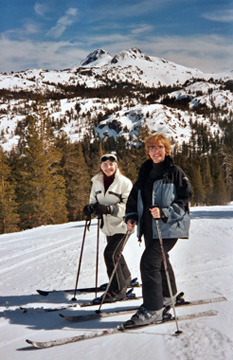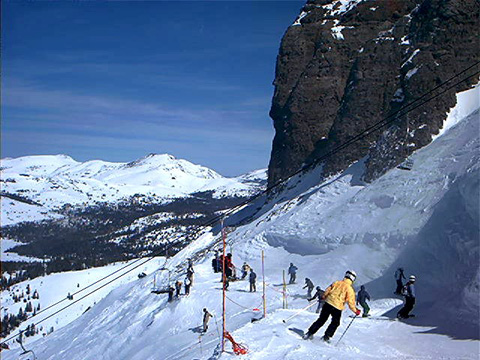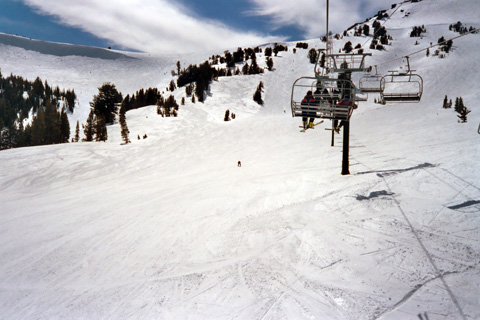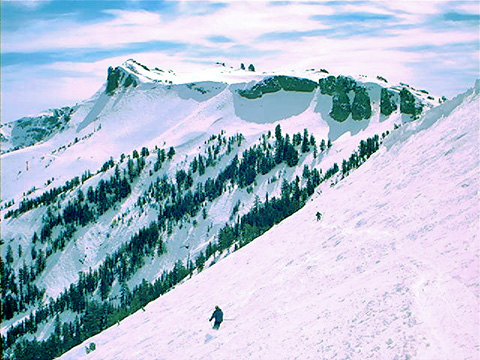
|
|
Colleen Kenney, left, and Paula Hewitson soak up the sun on Caples Crest. Photo provided by Jim Kenney.
|
Deep in the High Sierras about an hour east of California’s gold rush country a magnificent ski area rises above a large, otherwise remote alpine meadow. The place is Kirkwood Mountain Resort and modern day adventurers are drawn to it from all across the San Francisco Bay area. Like the ‘49ers of old, these fortune hunters are after gold, but it’s a white variety. And they invariably strike it rich, for Kirkwood’s motherlode yields prodigious amounts of fresh snow and black diamond ski terrain.
Not so well known among those of us from the East, the beauties of Kirkwood’s 2,300 acres of terrain have been touted by my West Coast cousin Paula Hewitson ever since we discovered a mutual love of skiing during a family reunion yakfest in 1997. Paula and her husband Rusty, Bay area residents, have been owners of a slopeside vacation condo for half of Kirkwood’s 33 year history.
Due to the demands of life and probably because there’s a whole lot of good skiing between here and there, I had never made a visit to Kirkwood until recently. After spending three days there in March 2005, I’m a complete believer in Paula and Rusty’s home mountain and ready to add Kirkwood to my short list of places I could spend a skiing eternity.
My curiosity about Kirkwood was piqued around New Years Day, 2005 when a barrage of huge snow dumps cycled through the Tahoe area making national news again and again. While this “Pineapple Express” weather pattern brought California one of its wettest winters on record, we in the mid-Atlantic suffered through a disastrous January thaw. Located about 35 miles south of Lake Tahoe and with one of the highest bases in the region (7,800’), Kirkwood was the virtual epicenter of the historic snows.
The timing finally seemed right to pay my respects to cousin Paula, and I made arrangements to visit Kirkwood with my two daughters during an early March college break. We arrived at Kirkwood in the middle of a pitch-dark night and couldn’t see a thing of the mountain except the lights of a grooming machine hovering high above us like a UFO. That sighting was a good omen, for in the coming days I would learn to greatly appreciate Kirkwood’s expanded high angle trail grooming program.
On our first morning at the resort I set out on foot to scout the base area and gape at the impressive, sweeping headwalls that cap the main ski terrain of Kirkwood around 9,876’ Thimble Peak. Perhaps with characteristic western directness, the key terrain features of Kirkwood have received succinctly descriptive labels: The Wall, The Wave, The Drain, The Cornice, and The Cirque.
I was eager to ski or at least view each of them close-up, but I had to improvise first. Due to a SNAFU with our air carrier my family’s ski equipment was stuck somewhere in the Friendly Skies (the gear was finally delivered about 10 p.m. after our first day). I had my boots, however, and I noticed a Rossignol demo tent offering me the opportunity to make lemonade out of lemons.
After checking that my two daughters were still sleeping-in at the condo I headed out the door and grabbed a pair of Rossi Bandit B3’s/168 cm for a 90 minute demo, sans ski poles. I took a warm-up run from the Solitude chair and made my way over to the Wagonwheel triple, which is designated “experts only” and provides a straight shot up ~1800 vertical feet to the highest lift-served spot on the mountain beneath the craggy Thimble Peak.
I understand that 60% of Kirkwood’s business comes from families, which may connote the bounteous softer side of the mountain, but let me make something perfectly clear. No serious skier/boarder can hop on an upper mountain lift at Kirkwood for the first time and not be STRUCK DUMB by the amount and quality of expert level booty waiting to be pillaged. As I took my introductory ride up the steeply pitched, safety bar-less Wagonwheel chair I felt an adrenalin-laced mixture of excitement and intimidation, the kind of feeling I got on first ascents of Snowbird, Utah or Taos, New Mexico, of for an eastern example, Whiteface, New York.
From the top of Wagonwheel all disembarking souls must deal with The Wall, Kirkwood’s signature in-bounds feature. It’s a steep, treeless headwall about a half-mile wide and nearly 1,000 vertical feet long. Though the sheer immensity of The Wall can be intimidating, on my visit it contained a groomed section (of the aforementioned high angle variety) that was readily doable by garden-variety black diamond skiers. Beneath The Wall spread another 1000 vertical feet of diverse and fun terrain unlike anything in the East.

|
|
Negotiating the Wall. Photo provided by Jim Kenney.
|
In fact, an East Coast person must learn a whole new geologic vocabulary to describe much of what awaits at Kirkwood including chutes, slots, cornices, lips, gullies, ravines, cliffs, cirques, bowls, and shoulders. Traversing below The Wall in a westerly direction you’ll come upon a fantastic series of deep ravines or natural half-pipes, some with skyscraper-like sidewalls lined with soft Sierra snow.
In this vicinity those 168cm Rossi’s came in dang handy when I picked my way down a snowy slot about 20’ wide between small rock cliffs. The snow pack was great for our visit, adding a measure of forgiveness to the challenging terrain. Fortunately, for an over-the-hill has-been that never-was like me, and my intermediate level daughters, there are also a thousand acres of sleek groomers, easy glades, and wide-open “hero” slopes waiting to be explored at Kirkwood.
Hero slopes were what I found after my solo morning ski demo session ended. I grabbed my daughters at our condo and we walked over to the rental facility in the Kirkwood Village Plaza. Focal point of the base area, the Plaza is anchored by a cute ice rink and also features the 43,000 square foot Lodge At Kirkwood offering premier upscale, ski-in/ski-out accommodations. After gearing-up with rentals the three of us took off for a mellow afternoon trek over Caples Crest and into the expansive Sunrise section of the mountain, home of The Wave.
Of Kirkwood’s distinctive terrain features, The Wave is the most accessible to intermediates. From half way up the long Sunrise Quad Chair (vertical rise ~1,200’) it looks exactly like a 100’ tsunami of snow breaking through two High Sierra peaks. In a California Surfer Dude type of way, The Wave captured the imagination of my kids. Given the tremendous snow pack during our visit its crest featured an awesome five story cornice drop, but surrounding it were some gigantic, treeless, ego boosting, blue square ballrooms.

|
|
View of the Wave (left) from Sunrise Chair. Photo provided by Jim Kenney.
|
The fun vibe in this section continued with a popular outdoor BBQ grill at the base of the Sunrise lift serving up burgers and reggae music. This outstanding intermediate level playground connects with the main Kirkwood base via easy runs beneath the Iron Horse, Caples Crest, and Snowkirk lifts. A mellow snowrider could take a day or more just exploring Sunrise and the routes over and back.
On our second day at Kirkwood we regained our own ski equipment and spent time with a larger group of relatives and friends getting acquainted with the nice variety of upper intermediate terrain served by the Solitude and Reut chairlifts. We also enjoyed some much easier blue and green runs off The Hole In The Wall chair (500’ vertical) serving the stand-alone Timber Ridge beginner trail pod, which is large enough to encompass practically an entire ski area in the mid-Atlantic.
Eventually my girls encouraged the group to head back to The Wave and try their favorite adjacent cruiser - Happiness Is. This time, however, I noticed that the Sunrise lift also provided access to Thunder Saddle, an in-bounds link to conventional black diamond portions of The Cirque.
The upper reaches of The Cirque constitute something altogether different, a rugged backcountry area of “if you fall, you die” cliffs recently featured in the March/April 2005 issue of Ski Magazine. Peering over a rocky drop in the area of Larry’s Lip, it was obvious to me why The Cirque has been chosen as a venue for several extreme freeskiing competitions. The resort offers an “Expedition: Kirkwood” program teaching backcountry skiing skills on some of this terrain.
Later in the day I got a chance to break away on my own. Descending again from Kirkwood’s highest point off the Wagonwheel chair I took one of those runs a ski junkie doesn’t soon forgot. Permit me a mid-Atlantic digression. I spent 15 of my formative years as a pass holder at Pennsylvania’s Blue Knob ski area. When Mother Nature cooperates it has some challenging terrain that to this day provides my personal skiing touchstone.
I salute Kirkwood with the following comparison to some of the best trails of Blue Knob. In a 15 minute run from the top of Wagonwheel I started with an 800’ vertical plunge down The Wall, reminiscent of a groomed Extrovert on steroids. Then I briefly traversed over to a softly moguled ridgeline and skied down a narrow shoulder of it between cliffs and pines. This reminded me of Edgeset, only it went on for about 400 vertical feet. Then the run bottomed out in a huge gully called The Drain for 600 more vertical feet down what looked like the Ditch Glades after being swept clean by an avalanche.
Near the end of that particular run I blurted out, “Yes, I can do this.” Kirkwood is the kind of place that can raise the juices in an old man to Barry Bondsian levels. It’s also the kind of place where a throwback kind of guy like me would probably buy a helmet if I skied it more regularly.
On our third and final day I spent the better part of the morning concentrating on the terrain around Kirkwood’s only high-speed chair, the four-year-old Cornice Express quad. Serving approximately 1,400 vertical feet of relentless steeps, this is the place to log some high quality, thigh burning, black diamond mileage, especially on an empty weekday.

|
|
Bodacious Kirkwood ski terrain. Photo provided by Jim Kenney.
|
Three or four runs off the Cornice Express benefit from Kirkwood’s high angle grooming and one called the Sentinel Bowl is particularly doable by solid intermediates. The views of Thimble Peak, The Sisters, and Glove Rock (all 9,000’+ pinnacles) from atop the Cornice ridge are the most dramatic at Kirkwood. More high traversing allows for some tremendous exploring in ungroomed terrain east or west of this lift.
At one point, searching for members of my group, I rode a chairlift in the beginner area below the Cornice Express. My lift companion was an age 30-something lady with an accent from somewhere around Charlotte, North Carolina. She was also looking for a child.
She told me she was a regular at Winterplace Ski area in West Virginia, while also making annual trips to Kirkwood for the last half dozen years. Her devotion to this terrific, but remote corner of the Sierras tickled me and I asked her, “why Kirkwood?” Eying the summit of the Cornice Express her surprising reply was, “for the steeps.” More evidence of one of my favorite theories, master the nuances of our modest mid-Atlantic mountains and you’re ready to take on ski terrain just about anywhere.
The rest of our last day was spent in sun drenched play with family and friends on trails served by The Reut and Solitude chairs, again tapping into a sweet mix of groomers and distinctive ravines and gullies. We also made one last romp through the Sunrise section to ride The Wave.
On our return to the Kirkwood base area we took a lovely, scenic cruise down the Juniper trail beside the Caples Crest lift. This area is decorated with occasional 1,000-year-old cedar trees lording over it like a cadre of ancient ski patrolling Ents from JRR Tolkien’s Middle Earth. Pausing here and there for final keepsake photo ops, you might say our skiing fellowship had climbed the mountain and accomplished our goal of a great ski trip to California’s High Sierra.
The intense March sunshine of the Tahoe region, combined with daytime highs between the low 40s and low 50s, required an East Coastie to dress outside the box. Given my Irish ancestry I was splashing on sunblock several times a day with only moderately successful results. The snow quality remained good on the upper mountain until our last day when temps in the 50s made everything a little overcooked, including us. I felt like I should have been wearing running clothes, not ski clothes. Eventually I dumped even a thin outer shell.
Along this vein, Kirkwood’s high base is an advantage that should not be underestimated. The Tahoe resorts tend to get huge snowstorms followed by glorious periods of sunshine and relatively mild weather. This is great for photographers, people who ski in shorts, and sunblock salesmen, but it can create sloppy conditions at lower California ski areas. Kirkwood’s 7,800-9,800’ elevation preserves relatively good snow quality between dumps and means dryer snow during dumps.
One of my few misgivings about the Kirkwood visit was - not enough time. I thought Kirkwood skied absolutely huge, bigger than any 2,000’ vertical mountain I’d ever been to. “If you can see it, you can ski it” is the catchphrase for much of this place. The area could easily incorporate ten more lifts along miles of high ridges. I am told several chairlifts are on the drawing board along with a new mountaintop restaurant for Caples Crest.
Though currently there are really only three upper mountain lifts, the deep ravines and multiple faces accessible from the Wagonwheel and Cornice Express chairs provide countless nooks and crannies. The Sunrise chair opens up huge expanses of treeless terrain. Traversing from the top of any of these lifts for a half-mile to a mile in either direction leads to adventurous slots, secret gullies, remote glades, or solitary mountainsides even on relatively busy weekends.
I’m a skier, but it was my sense that Kirkwood was an especially great place for snowboarders. We saw plenty of boarder-dudes laying down elegant high angle turns. The ratio of Boarders to Skiers seemed high, maybe 50-50. The mountain has very few flats or pedal-inducing runouts. There are some high traverses that could present some problems, but the epic, untracked terrain they unlock is worth the trouble. About a half dozen lifts provide direct fall lines of 1,000 vertical feet or more.
The mountain was set-up with three different size terrain parks during my visit. The largest one included a huge halfpipe. And then there are the extraordinary natural halfpipes like The Drain. You ain’t seen a halfpipe ‘til you’ve seen the kind God can make: 100-200’ sidewalls, half a mile long, with cliff jumps and slots thrown in to keep you on your game.
Notwithstanding the luxurious Lodge At Kirkwood, overnight accommodations at Kirkwood are condo-centric. Outside an active Happy Hour atmosphere on weekends around the Village Plaza, hot tubs, TV, and bottles of California wine highlight nighttime recreational diversions.
One evening, however, my group visited the old Kirkwood Inn, a 19th century stagecoach/pony express stop and one of the few pre-ski area structures located in the vicinity. Built at an elevation of 8,000’ in 1864 by local cattleman Zachary Kirkwood, this large, rustic log cabin is a great testimony to the westward pioneer spirit. Nowadays it provides spirits of another sort as a local eatery and saloon.
Kirkwood has a distinctly “locals” flavor compared to some other Tahoe resorts. Weekend lift lines were never more than a couple minutes, but lots of skilled, fast moving snowriders meant gapers like myself had to remain alert at major trail junctions. Weekdays were another story as we had the entire ski area virtually to ourselves.
I have seen reports of an ability gap at Kirkwood, between the intermediate and expert levels. Don’t tell my daughters that. They fall precisely in that skill zone and not once over three days did they tire of the copious quantities of cruisers found in Sunrise, Caples Crest, and on the lower mountain terrain beneath The Wall and The Cornice. I recommend the Sentinel Bowl off the Cornice Express as an advancing intermediate’s best introduction to some of Kirkwood’s higher delights. High angle grooming tames a little bit of this beast.
Fast facts: 2,300 skiable acres; 12 lifts; base elevation 7,800 feet; summit elevation 9,800 feet; vertical rise 2,000 feet; average annual snowfall 500 inches; 2005 daily lift-ticket price $59, but there are tons of deals like kids ski free on Sundays and adult two-day tickets for $88 throughout much of the season.
Husband, father and retired civilian employee of the Department of Navy, Jim Kenney is a D.C. area native and has been skiing recreationally since 1967. Jim's ski reporting garnered the 2009 West Virginia Division of Tourism's Stars of the Industry Award for Best Web/Internet/E-Magazine Article.

Join the conversation by logging in.
Don't have an account? Create one here.